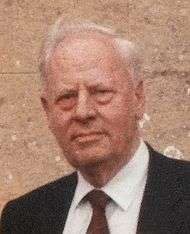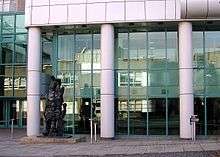Michael Swann
Michael Meredith Swann, Baron Swann, FRS,[1] FRSE (1 March 1920 – 22 September 1990) was a British molecular and cell biologist. He was appointed chairman of the BBC, awarded a knighthood and subsequently a life peerage.
The Lord Swann | |
|---|---|
 Michael Swann in 1987 | |
| Born | Michael Meredith Swann 1 March 1920 |
| Died | 2 September 1990 (aged 70) |
| Nationality | British |
| Education | Winchester College, Hampshire Gonville and Caius College, Cambridge |
| Known for | The mechanisms of cell division and fertilisation |
| Spouse(s) | Tess Gleadowe (1942–1990; his death); 4 children |
| Scientific career | |
| Institutions | University of Cambridge University of Edinburgh |
Early Life
Swann was born in Cambridge, the eldest of three children of pathologist Meredith Blake Robson Swann and his wife, Marjorie Dykes.[2]
Swann was educated at King's College School, Cambridge,[3] and then at Winchester College, a boarding independent school for boys in the city of Winchester in Hampshire, where he was an Exhibitioner. He then studied Zoology at Gonville and Caius College, Cambridge, where he graduated MA.[4]
Life and works
He served with the British Army during World War II, rising to the rank of lieutenant colonel, and being Mentioned in Dispatches.[5] From 1946 Swann lectured in zoology at the University of Cambridge, his former Alma Mater.[6]
He moved to Edinburgh University as Professor of Natural History in 1952. In 1953 he was elected a Fellow of the Royal Society of Edinburgh. His proposers were James Ritchie, John Gaddum, Sir Maurice Yonge and Harold Callan. He won the Society's Makdougall Brisbane Prize for 1970/72. In 1962 he was elected a Fellow of the Royal Society of London.[7]
His academic work was on the mechanisms of cell division and fertilisation. He used cell polarisation methods to understand the changes in molecular organisation of the mitotic spindle. With his collaborator Murdoch Mitchison, he found evidence in support of a new theory of cell division. He collaborated with Victor Rothschild in experiments on changes in membrane structure during fertilisation.
From 1965 to 1974, he was the Principal and Vice-Chancellor of Edinburgh University. In 1968, he was awarded an honorary Doctorate of Science by the University of Leicester.[8] During his term as Principal, he encountered difficulty with students led by Gordon Brown who had unusually been elected as Rector of the University.[9] He received a knighthood in the 1972 Birthday Honours,[10] having the honour conferred by the Queen herself on 5 December 1972.[11]
He was Chairman of the Governors of the BBC from 1973 to 1980 having been appointed by Conservative Prime Minister Edward Heath, who admired his strong leadership during student protests at Edinburgh University.[12] He was created a life peer as Baron Swann, of Coln St Denys in the County of Gloucestershire on 16 February 1981.[13][14] In 1980 Swann became Provost of Oriel College,[15] although he resigned after nine months,[16] and was also Chancellor of the University of York from 1979 until his death.[17]
In 1969 he led the Swann Report "on The Flow into Employment of Scientists, Engineers and Technologists". In 1985 he led the Swann Report "Education for All", a report of the Committee of Enquiry into the Education of Children from Ethnic Minority Groups.
He died in London on 22 September 1990.
Legacy
The Michael Swann Building of the University of Edinburgh at Kings Buildings is named after him. It continues to be used for work on cell division and fertilisation to this day.
Family
In 1942, he married Tess Gleadowe (died 2009). They had two sons and two daughters.

- Brother, Hugh Swann, cabinet maker to the Queen
- Uncle, Brigadier Vivian Dykes, Chief Combined Secretary British Joint Staff Mission Washington, 1942
- Stepfather, Sir Sydney Castle Roberts, Secretary of Cambridge University Press, author; Vice-Chancellor of the University of Cambridge
- Brother-in-law, Monsignor Graham Leonard
References
- Mitchison, J. M. (1991). "Michael Meredith Swann Baron Swann of Coln Denys. March 1920-22 September 1990". Biographical Memoirs of Fellows of the Royal Society. 37: 446–460. doi:10.1098/rsbm.1991.0023.
- "Swann, Michael Meredith, Baron Swann (1920–1990), biologist and public servant". Oxford Dictionary of National Biography. doi:10.1093/ref:odnb/9780198614128.001.0001/odnb-9780198614128-e-40021. Retrieved 3 May 2019.
- Henderson, RJ (1981). A History of King's College Choir School Cambridge. ISBN 978-0950752808.
- "Michael Meredith Swann". JSTOR 770039. Missing or empty
|url=(help) - "Lord Swann, 70, Former Chief of BBC And Educator, Dies", Associated Press via New York Times. 24 September 1990.
- Profile, University of York. York.ac.uk; retrieved 2 June 2014.
- Biographical Index of Former Fellows of the Royal Society of Edinburgh 1783–2002 (PDF). The Royal Society of Edinburgh. July 2006. ISBN 0 902 198 84 X. Archived from the original (PDF) on 4 March 2016. Retrieved 13 October 2018.
- Honorary Graduates, le.ac.uk; retrieved 2 June 2014.
- Lady Tess Swann obituary, The Independent, 13 October 2009.
- "No. 45678". The London Gazette (Supplement). 3 June 1972. p. 6256.
- "No. 45849". The London Gazette. 12 December 1972. p. 14743.
- BBC Chairmen listing The BBC
- "No. 48529". The London Gazette. 19 February 1981. p. 2441.
- Heraldic Media Ltd., Patrick Cracoft-Brennan Cracroft Peerage Database v5.2
- "Who, Where and When: The History & Constitution of the University of Glasgow Oxford" (PDF). Archived from the original (PDF) on 25 July 2006. Retrieved 3 April 2008.. University of Glasgow
- Sisman, Adam (2010). Hugh Trevor-Roper: The Biography. Weidenfeld & Nicolson. p. 451.
- Greg Dyke to be Chancellor of the University of York. BBC. 11 November 2003
External links
| Wikimedia Commons has media related to Michael Swann. |
| Media offices | ||
|---|---|---|
| Preceded by Lord Hill |
Chairman of the BBC Board of Governors 1973–1980 |
Succeeded by George Howard |
| Academic offices | ||
| Preceded by Edward Victor Appleton |
Principals of the University of Edinburgh 1965–1974 |
Succeeded by Sir Hugh Robson |
| Preceded by The Right Honourable The Lord Clark |
Chancellor of University of York 1979–1990 |
Succeeded by Janet Baker |